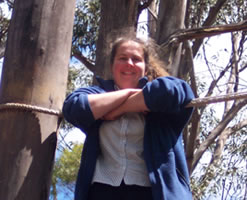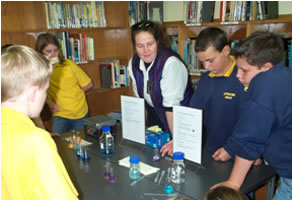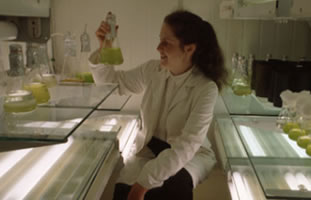|

Not my usual office – but
a great place to be!
This
is my day…
7.30
am Read Terry Pratchett’s Science of Discworld over breakfast.
Great book. Links science theory with a Discworld story - my
sort of writing…
9.00
am Arrived at office – Faculty of Science, Engineering
& Technology University of Tasmania. I’m the “Science
Marketing and Communication Officer,” full-time, as of
this year.
Checked and replied to email – heaps as usual.
Paid Australian Science Communicators registration. Have to
set a good example, particularly as I’ve just taken over
the role of Tasmanian branch co-ordinator.
Booked accommodation for Future Moves, a traveling course and
career program that visits schools and colleges on the north-west
coast of Tasmania. Heading off mid- May for 4 days.
Edited article for University’s newsletter on the winning
science teacher for the 2005 Prize for Science/Maths Teaching
in Secondary Schools presented at the Research & Teaching
Awards Evening at Parliament House.
11.30
am Faculty meeting – planning and review.
12.30
pm Time for lunch break today – yay! This doesn’t
happen very often.
1.30 pm Worked on schools activities program for National Science
Week - not until August but the teachers kit is being developed
through the Australian Science Teachers’ Association and
sent out in May, hence the early deadline. Quite a few organisations
are running school activities, so have to make sure I get all
the details right.
Edited the National Science Week minutes from last meeting and
distributed to co-ordinating committee members (Tasmania). Elected
as the chair of this committee – fourth year in a row
– it’ll have to be someone else’s turn next
year!
Organised campus visit for regional high school and planned
what research facilities the students would be visiting, e.g.
the radio telescopes out near the airport (need to factor in
extra time for travel), the environmentally-controlled glasshouses
up at Plant Science, the engineering workshops, the central
science lab over at Chemistry. Still have to check availability
of staff but the visit is during semester break, so hopefully
no problems.
Worked on grant proposal for developing science teaching units
linking to some of the University’s research areas. –
very exciting project, but heaps of work and the deadline is
looming.
6.00
pm Checked email – before heading off home.
7.30
pm Over tea, brainstormed next Curie-ous Kids session . Curie-ous
Kids is the CSIRO Double Helix Science Club program held at
the CSIRO Education Centre after school on Tuesdays. About 20
members from Years 5 – 8 usually turn up. I co-ordinate
the program and trying to come up with something new each week
isn’t always easy! Maybe something on food … building
the Huygen-Cassini probe out of lollies was a real winner.
9.00
pm Time to finish up for the day. Nothing worth watching on
TV so might just go back to reading Terry Pratchett.

Testing
the protein and glucose content of foods.
This is my job…
POSITION
SUMMARY:
The Science Marketing and Communication Officer is responsible
for the promotion of courses offered by the Faculty of Science,
Engineering & Technology to domestic markets, through the
development, implementation and evaluation of a range of programs
and resources targeted at students, teachers, careers advisors,
and the general public.
The
Officer is responsible for co-ordinating the integrated approach
to marketing and communication activities across the Faculty,
and in collaboration with the University Student Recruitment
and Marketing Unit.
The
Officer will be involved in regular public speaking and professional
presentations to a variety of audiences and play a key role
in community liaison activities. Additionally, the Officer will
liaise with representatives from state and commonwealth departments
for science, education and training, and external science-related
organisations, to develop mutually beneficial science awareness
programs. Out-of-hours activities are involved and the Officer
is required to participate in marketing and promotional events
throughout Tasmania and interstate.
PRIMARY
TASKS:
1.1. To co-ordinate Faculty programs (involving planning, advertising,
reporting and evaluation), including:
• Siemens Science Experience
• Science Roadshows
• Science Teacher Professional Development program
• Open Day/Science Expo
• Young Tassie Scientists
• National Science Week programs
1.2. To co-ordinate the production and distribution of marketing
materials (eg. brochures, posters, careers information, newsletters,
on-line resources).
1.3. To prepare grant applications to enable the implementation
of promotional activities and to administer grants awarded to
the Faculty for the promotion of science, engineering and technology.
1.4. To investigate opportunities to promote science, engineering
and technology courses through national student-based activities
(eg. National Youth Science Forum, Student Research Scheme,
Science Olympiads, Science and Engineering Challenge).
And
this is my story…
I
never really saw myself becoming a scientist – or a science
communicator. At school, I didn’t have any particular
interest in science – but did love reading and writing
poetry. Kept my options open and studied Maths, Physics, Chemistry,
English and French at Year 12. At University, I followed the
science path, majoring in microbiology and biochemistry - would
have liked to studied some arts subjects, but too many timetable
restrictions and no such thing as a combined Science-Arts degree
in those days. Went on to work in marine biology at CSIRO Marine
Research in Hobart, and spent the next 15 years studying microscopic
phytoplankton.

Checking
out some microalgal cultures at CSIRO.
Why study science? In my talks to students I say that it provides
an opportunity “to contribute to the understanding of
our world, and to share this knowledge with others,” but
I think Claire Hooker in her recent book Irresistible Forces
– Australian Women in Science puts it better when she
writes that it’s all about “the pleasure and the
fun – the desire to find stuff out and to tell people
about it.” That about sums it up nicely.
And
I think it’s really important that scientists can communicate
their scientific research so that it’s understandable
and interesting - which is how I got into the science theatre
side of things, and more recently science art. Using these media
to tell science stories is a creative delight, and a challenge
- and truly rewarding for participants, audiences, and co-ordinators
like me!
Where
do I see myself in the future? Good question. Still trying to
work this out myself. Maybe the Director of Science Communications
for the University (a position yet to be created), possibly
working for the National Institute of Communicating Science
through Theatre and Art (an institute yet to be established),
even getting involved in the rapidly expanding eco-tourism industry
(an option yet to be explored) - or perhaps just taking life
easy, under a gum tree…
|